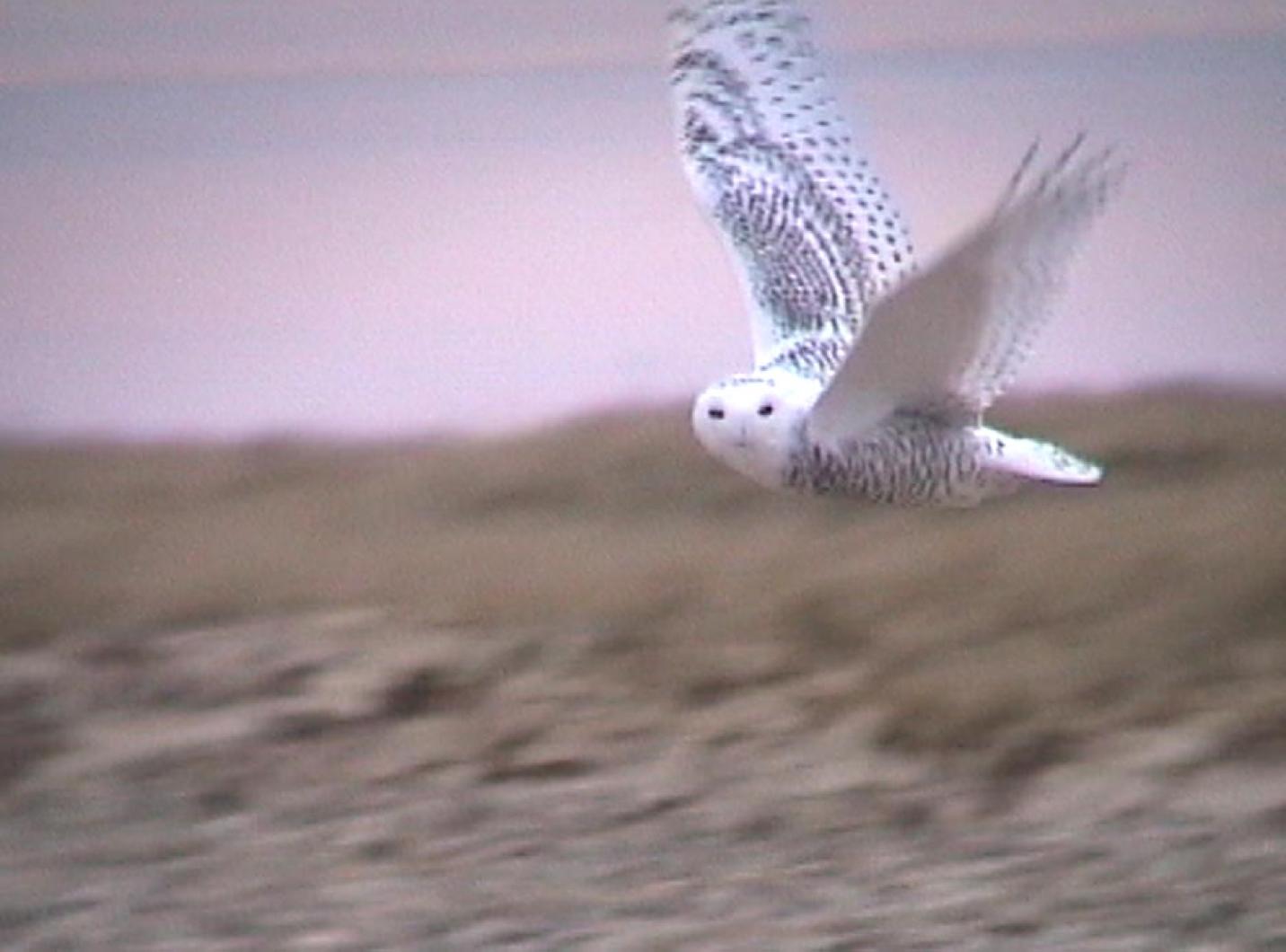Chappaquiddick has a powerful and stunning visitor from the North. Olsen Houghton and Joel Graves were between the Cape Pogue Gut and Cape Pogue Lighthouse on Dec. 2 and spotted a snowy owl working over the dunes. They were able to videotape the bird and watch it for quite a while.
The striking white color of a snowy owl is what catches your eye on the Vineyard. Yet these same white feathers provide perfect camouflage in the snowbound northern climes which are this owl’s normal habitat. Standing tall, this large arctic owl tops two feet, and when it flies the wing span is an impressive six feet. There is no other North American owl which is this big, has a round head and piercing yellow eyes. A powerful hunter, this owl normally feeds its young small rodents known as lemmings, but can take Canada geese, brant, ducks or grebes as well as rabbits and squirrels with its potent talons. There are some reports of snowy owls wading into the water to catch fish. Talk about hungry.
The Chappaquiddick snowy owl is probably a first-year female because of the amount of dark barring on the breast and wings. The young males usually show less barring and the adult males are almost pure white.
The breeding behavior of the snowy owl is interesting. First the male chooses the choice habitat by wandering around in the tundra until he finds a place that provides plenty of food. In years when there are few lemmings, the snowy owls might not nest knowing that there is not enough food for themselves and their offspring. The male attracts a female not by offering her chocolates and champagne, but by doing a dance in front of her while dangling a lemming from his beak. Pure sex!
The nest is a mere scrap in the ground on the highest spot in the tundra. A bit of moss, lichen or feathers line the nest. The female lays her clutch of eggs and the number depends on the availability of food. It can range from three to thirteen or more. The eggs are laid daily so the female starts incubating the first egg while she is laying the others. This means that the first chick born is going to be a good deal larger than the last one born. The eggs take about 30 days to hatch and the young leave the nest about 16 days later. The male feeds the female who continues to sit on the nest and the young as they leave the nest and when all have left, both male and female continue to feed the young until fall.
The ermine owl, as the snowy owl has also been called, can fly up to 50 miles per hour. Some years we have been lucky enough to have a snowy owl spend the winter in the dunes on Joseph Sylvia State Beach or the Martha’s Vineyard Airport, making viewing this splendid owl easier.
Bird Sightings
Getting caught up after being away for a spell includes a Nov. 12 sighting of pine siskins at Steve and Happy Spongberg’s feeder in Chilmark and a Nov. 13 fox sparrow at Tim and Sheila Baird’s feeder in Edgartown. Scott Stephens had a yellow-bellied sapsucker at his Pilot Hill yard in Tisbury on Nov. 30, and on the same day he spotted a palm warbler in the fields.
Gus Ben David was exercising his golden eagle on Nov. 28 and noticed that the eagle was looking upwards at some speck in the sky. Gus looked at the speck with his binoculars and identified an immature bald eagle. This shows amazing eyesight on the part of the golden eagle.
On Nov. 27 Flip Harrington spotted an eastern meadowlark at Black Point in Chilmark, an eastern towhee and a merlin at Quansoo and two tufted titmice in the Quenames woods.
On Nov. 30 I spotted a pine siskin at our feeder at Quenames in Chilmark.
On Dec. 1 Flip Harrington found a flock of seven eastern meadowlarks at Black Point. The same day Peter and Aidan Huntington spotted four harriers and an unidentified heron at Crab Creek in Chilmark.
On Dec. 2 the snowy owl was first seen on Chappaquiddick by Olsen Houghton and Joel Graves.
On Dec. 3 Tim and Laurisa Rich reported that they had a surprising late female Baltimore oriole at their Chilmark feeder and that with the cold weather tons of house finches have arrived and one male purple finch. The same day Laurel Walker, Catherin Colon and Carol Bell birded Katama, Norton Point and Edgartown Great Pond. They found the usual waterfowl suspects in the Great Pond but were amazed at the large, over 100, flock of scaup. The birds were out of range so they could not tell if they were greater or lesser scaup. They spotted horned grebes, red-throated loons and a great blue heron at or off Katama and a lone coot at Crackatuxet Cove. Penny Uhlendorf and Scott Stephens had two pine siskins at their feeder at Pilot Hill on Dec. 3.
On Dec. 4 Laurel Walker had a pine siskin at her Abel’s Hill feeder and has had tufted titmice daily. Flip Harrington and I were delivering Vineyard Birds II to Felix Neck and Flip spotted a hawk perched over the butterfly garden. As I approached the hawk flew; it was a nice male sharp-shinned hawk. Tim and Sheila Baird had a golden-crowned kinglet at their Edgartown feeder and have a resident sharp-shinned hawk. Allan Keith has a flock of red-winged blackbirds that are in and out of his yard in Chilmark as well as a field sparrow.
Please call in your bird sightings to the hotline at 508-627-4922.







Comments
Comment policy »